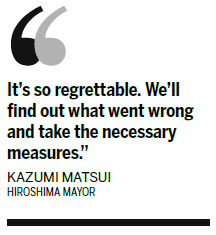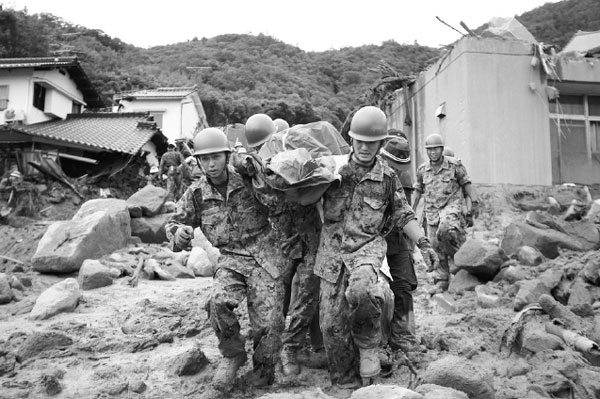Landslides engulf homes, kill at least 36
Hiroshima sees record-breaking level equivalent to a full month's worth of rain
Huge landslides in western Japan killed at least 36 people and left rescuers scrambling to find another seven still missing, authorities said Wednesday, after a wall of mud smashed into their homes.
Dozens of houses were buried when hillsides collapsed after torrential downpours in Hiroshima, television pictures showed, leaving rescuers to pick through the devastation for any signs of life.
|
Japanese Self-Defense Force soldiers and police officers carry the body of a victim at a site where a landslide swept through a residential area at Asaminami ward in Hiroshima, western Japan, on Wednesday, when at least 32 people, including several children, were killed as landslides triggered by torrential rain slammed into the outskirts of the western city of Hiroshima. Toru Hanai / Reuters |
A spokesman for Hiroshima Police told AFP the death toll was still climbing.
"The figures may change as the rescue efforts continue," he warned.
"There was rain and thunder all night, beating down so hard I was scared to go outside," a resident told Fuji TV. "Great big drops. I've never seen anything like this."
Helicopters hovered overhead, lifting out survivors, as rescue workers searched through mud and piles of stones in residential areas about 5 km from the city center.
Among those dug out of the debris were two brothers, aged 11 and 2, whose house was struck as they slept.
A child's red school bag, covered in mud, lay in the debris. Houses had been pushed 100 meters by the landslide in the worst-hit area, where thick, knee-high mud hampered rescue efforts.
"The rain was just pouring down, and the street in front of my house turned into a river," a man in his 70s told national television NHK.
The number of dead had risen rapidly from an initial toll of four, which included a 2-year-old boy.

Among the dead was a 53-year-old rescuer, who was killed by a secondary landslide after he had pulled five people to safety, the Fire and Disaster Management Agency said.
Aerial footage showed several houses buried in thick slurry, their wooden frames splintered by the weight of the mud.
Torrents of brown water raced off the mountains behind the homes and through the wrecked buildings, hampering rescuers' efforts as they searched for anyone still trapped.
Emergency workers were seen climbing up to the second floor and roofs of half-collapsed houses - some of which were floating - to try to reach any survivors.
The soil in the area was of a kind that absorbed water until it suddenly loosened and slid, increasing the danger, disaster management experts told NHK.
Cities in land-scarce Japan often expand into mountainous areas, leaving such development vulnerable to landslides.
About 240 mm of rain fell in the area in the 24 hours up to Wednesday morning, a record-breaking level equivalent to a month's worth of rain in a usual August, the Meteorological Agency said. About half of that rain fell in one hour on Wednesday.
The force of the landslide crumbled asphalt roads, while streams of mud tore through neighborhoods, turning houses into piles of twisted wreckage. Boulders with a diameter of as much as 3 meters lay scattered around.
AFP - Reuters - AP
(China Daily 08/21/2014 page11)















